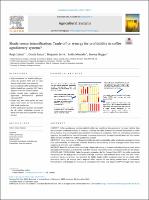Shade versus intensification: Trade-off or synergy for profitability in coffee agroforestry systems?

View/
Date
11-12-2023Sustainable development goals
ODS 12 - Producción y consumo responsables
Type
Artículo
Metadata
Show full item recordAbstract
This study assesses the economic viability of different coffee production strategies in Costa Rica and Guatemala, comparing intensive systems with shaded agroforestry approaches. Using a typology based on levels of intensification and sustainability, the authors applied a stochastic cash flow model based on ten years of farm-level survey data, including information on costs, prices, and yields.
Results indicate that high-productivity systems—with significant investment and moderate shade levels—achieve the highest Net Present Value (NPV) under future coffee price scenarios. Among low-investment systems, those with high shade cover yield a higher (and positive) NPV than low-shade systems, which on average produce negative returns despite similar investment levels. Diversification, particularly with high-value export avocados, marginally improves NPV, while other forms of diversification have limited economic impact.
Although high-productivity systems incur greater production costs, they generally offer higher probabilities of achieving positive net income and living wages, except in cases of severe price drops (e.g., a 50% decline in coffee prices). Conversely, a 50% increase in coffee prices would be necessary for all farmers to achieve positive net cash income and, in the case of intensive systems, approach a living wage threshold.
The study concludes that high-investment, high-productivity coffee systems are compatible with shaded agroforestry and are more likely to ensure economic success under most market conditions. For farmers with limited capacity to invest, high-shade systems offer more stable and positive returns across a wider range of price scenarios than low-shade alternatives.
Keywords
Delegation
Sede Central
Publisher
Elsevier
Is part of
Agricultural Systems
Status
openAccess
xmlui.dri2xhtml.METS-1.0.item-uri-link
https://doi.org/10.1016/j.agsy.2023.103814

